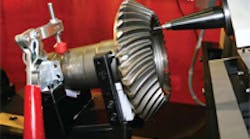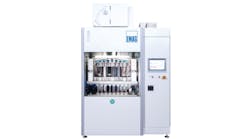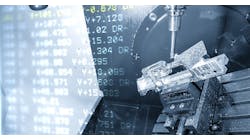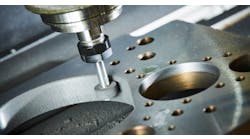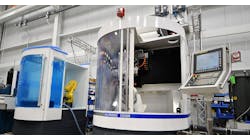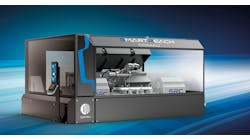A Columbia marking machine works on
For a major helicopter manufacturer, Columbia Marking Tools (www.columbiamt.com) designed and built a special marking machine that placed both manreadable and UID/2D or Square Dot vision readable codes on a variety of 17 different gear and gearbox components.
The identification marks include two lines of copy plus a UID/2D or Square Dot code. A third line of text can be included if there is space available in the prescribed marking location.
The machine is a stand-alone system with industrial casters on its base. It is designed to be moved easily around the shop floor so that it can be positioned in different partproduction areas.
In addition, Columbia designed and built individual part fixtures for 17 different components.
Matt Fournier, Columbia machine design engineer, said fixturing for the project presented several challenges:
First, the customer wanted changeover to be fast, between 5 min and 10 min and with minimal adjusting.
Second, fixtures had to locate and lock in position with the marking spindle and pin in the same mark location fixture-to-fixture.
Third, fixtures had to locate and lock the parts with no part surface marring or damage.
Fourth, the different part fixtures had to be loaded off the machine with an ergonomic slide-feed-chase fixture that was designed for easy operation and positioning. Finally, the software and the touch screen of the machine PCS control had to be programmed for each part.
Fournier said Columbia met these challenges successfully and achieved a changeover time of one minute.
The marking unit, a standard Columbia dot-peen-scribe CNC marker, uses a special horizontal CNC stepper-motor-driven marking spindle, equipped with a heavy-duty, bearingsupported, extended pin housing to accommodate the varying reach requirements of the different parts.
The marker does ultra-fast dotpeen marks as well as Square Dot silent scribe marks.
Users can adjust marking depth control for the preset 4 in. by 6-in. marking area, and a provided carbide marking pin handles parts with hardnesses over 55 Rc.
Columbia’s own PCS 2000 HMI marking controller was designed specifically to apply UID/2D matrix codes that require marking equipment to be integrated with electronic cameras for mark verification. Within the control, Columbia pre-installed the Cognex vision/reader software that included both hardwire and Blue Tooth interfaces.
Lasit USA (www.lasitusa.com) said it has developed the first compact desktop rotary dial table fiber laser marking system.
Lasit USA said its RotoTab marking system sports a two-position pneumatic index table with a 400-mm plate and a low-voltage power source with 50 percent increased efficiency for low operating costs.
The fully enclosed Class One system is made with a fiber laser, galvo scan head, computer and FlyX and FlyCad software that supports both vector and raster engraving of graphics, logos, alpha-numerics, barcodes, 2D data matrix and serialized numbers. It was designed to be used for plastics, metals and other materials.
Shops can choose from a variety of lasers for the system, including fiber, Vanadate, CO2 and green. Spot sizes are customized per application, with the smallest spot providing micro-machining capability of alphanumeric parts the size of an eyeglass or medical implant screw.
